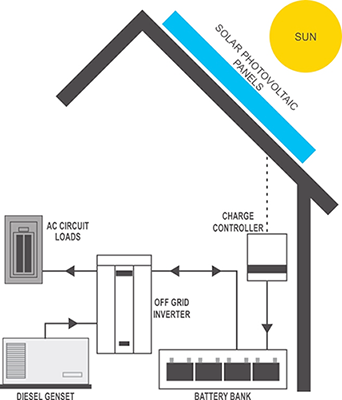Address
Unit 302, Tower 1, Assotech Business Cresterra, Sector 135 Noida 201301 (UP), India.
Work Hours
Monday to Friday: 9:30AM - 6:30PM
Address
Unit 302, Tower 1, Assotech Business Cresterra, Sector 135 Noida 201301 (UP), India.
Work Hours
Monday to Friday: 9:30AM - 6:30PM
The "Grid-Tie With Battery Backup or Hybrid" PV system incorporates one or more special AC circuits that are not directly connected to the electric grid like the rest of the building, but are always powered through the inverter and/or charge controller. These circuits may power a refrigerator, selected lights, computers or servers i.e. any devices the owner deems essential. The "dual function" inverter can supply the utility grid with any excess power produced by the system like the "grid-tie" inverter, plus the inverter works with the PV modules and battery bank (through the charge controller) to provide AC power to the backup circuits when the grid is down. The charge controller manages the battery voltage, keeping them fully charged when the grid is live, and preventing them from being depleted when the system is drawing power from them.

There are no batteries to store excess power generated--the electric utility essentially stores it for you through a system called "net-metering." DC (direct current) generated by the PV panels is converted into AC (alternating current) power by the inverter. Output from the inverter is connected to your existing distribution panel (breaker panel) that feeds the rest of your site. During periods when your grid-tie system is generating even more energy than your site requires, any excess is fed back into the grid for others to use and the electric utility company "buys" it from you. They provide credits to your account for all the power that is pushed back into the grid through the meter. And your meter will literally run backwards! When your site needs to draw more energy than it is producing (say, during cloudy conditions or at night), electricity is provided by the power grid in the normal manner.

The Off-Grid or Stand-Alone PV System incorporates large amounts of battery storage to provide power for a certain number of days (and nights) in a row when sun is not available. The array of solar panels must be large enough to power all energy needs at the site and recharge the batteries at the same time. A diesel generator is often employed for emergency backup power.
